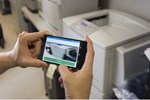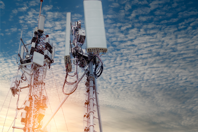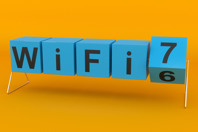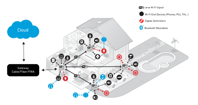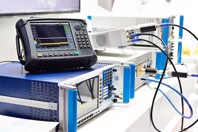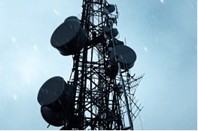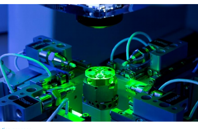INTERNET OF THINGS EDITORIAL & GUEST OPINIONS
-
Can mmWave Radar Give Industrial Robotics Better Spatial Awareness?
For safety, convenience, and productivity, mmWave radar sensors could be the best way to boost spatial awareness in machinery.
-
Breaking Down The Barriers In High-Frequency RF Engineering
Engineers designing RF systems at millimeter wave frequencies face exponentially increasing challenges as losses compound, parasitics dominate, and system integration becomes critical.
-
The Complete Guide To Radio Frequency Over Fiber Systems
Radio over fiber transports RF signals via optical fiber, enabling low-loss distribution for wireless networks, radar systems, and radio astronomy applications.
-
Beyond 5G AI, Terahertz, And Open RAN Transform RF Engineering
RF engineers are advancing 6G through terahertz communications, AI-driven network optimization, and Open RAN architectures, with major university research centers and NSF funding driving innovation toward 2030 commercial deployment.
-
Real-Time 3D: Game Engines Transform Digital Twin Applications for Wireless Networks
Game engines like Unity and Unreal have helped transform digital twins from engineering concepts into immersive 3D platforms that revolutionize RF network design and wireless testing.
-
Why Low-Band Spectrum Remains The Backbone Of Mobile Networks
As mobile operators chase higher-frequency bands for speed and capacity, the 600–900 MHz bands remain vital for wide area coverage, energy efficiency, and bridging the digital divide.
INTERNET OF THINGS NEWS FEATURES
 Back Channel — Rolls Royce And Nuclear Reactors On The Moon, Ultra-Low-Power IoT Through RF, The Father Of Polish RF, And More
Back Channel — Rolls Royce And Nuclear Reactors On The Moon, Ultra-Low-Power IoT Through RF, The Father Of Polish RF, And More
Back Channel presents the most captivating news and innovations in RF and microwaves. This week, we look at some AOC news, the successful test flight of an electric motor drive on a hybrid electric aircraft, a life well lived, and more.
-
Back Channel — Pressure To Design In Tighter Spaces, World's First Advanced-Ready 5G Modem RF Chip, 3D Lightning, And More
Back Channel presents the most captivating news and innovations in RF and microwaves. This week, we explore a couple of markets, congratulate an NSF CAREER award winner, and more.
-
Back Channel — Nanoscale 3D-Printing Material Could Offer Better Structural Protection, Designing Better Cars With Safety & Security In Mind, IEE MTT-S Calls For Nominations, And More
Back Channel presents the most captivating news and innovations in RF and microwaves. This week, we learn who the leading companies in missile aerodynamic guidance systems are, find out why the fiber optic cable market is expected to top $30 billion by 2029, dig into why the U.S. has a “unique opportunity” to lead the world’s IFE research, and more.
-
Back Channel — The Human Body As A 6G Antenna, NOAA Taking Stock Of Spectrum, A 3D Printing Roundup, And More
Back Channel presents the most captivating news and innovations in RF and microwaves. This week, we look at how Skyworks and Semtech are collaborating to launch LPWAN reference design for industrial and smart city applications, Rohde & Schwarz is contributing to the investigation of sub-THz measurement, and the U.S. and Japan warn that attacks on satellites may trigger a military response.
INTERNET OF THINGS NEWS
-
NUS Researchers Develop Wireless Light Switch For Targeted Cancer Therapy
A team of scientists from the National University of Singapore (NUS) has developed a way to wirelessly deliver light into deep regions of the body to activate light-sensitive drugs for photodynamic therapy (PDT).
-
Vanderbilt Wins Top Prize In First Round Of DARPA Spectrum Collaboration Challenge
In two years, the world may see a revolutionary solution to the century-old approach of allocating bands for specific use on the radio frequency spectrum. Vanderbilt may help solve the problem.
-
Wuxi DSP Technologies To Release China's First IoT-Embedded AI Chip
The "2018 IoT and Embedded AI Chip Platform and Eco Strategy Conference" will be held on December 8, 2017 at Intercontinental Hotel Beijing Beichen as one of the sub-forums at the "2017 IoT Developers Conference".
-
Chinese Tech Giants Baidu, Xiaomi Partner On AI, Big Data, And IoT
Baidu, Inc. (NASDAQ: BIDU) and Chinese consumer technology company Xiaomi today announced that the companies have entered into a partnership to establish in-depth cooperation, leveraging the two companies' strengths in artificial intelligence (AI) and Internet of Things (IoT) in order to offer an enhanced experience to users in consumer electronics and smart devices.
-
New Antenna In Alaska Expands Spacecraft Communications Capabilities
NASA’s newest communications antenna became operational today following a ribbon-cutting ceremony at the Alaska Satellite Facility in Fairbanks. The antenna will increase the agency’s communications support to Earth-observing missions.
-
CMU Leads Google Expedition To Create Technology For 'Internet Of Things'
Carnegie Mellon University will turn its campus into a living laboratory for a Google-funded, multi-university expedition to create a robust platform that will enable Internet-connected sensors, gadgets and buildings to communicate with each other. By Byron Spice
IOT WHITE PAPERS, APPLICATION NOTES, CASE STUDIES, & BROCHURES
-
Qorvo enables seamless 5G connectivity through advanced RF solutions, supporting applications from small cells to fixed wireless access, with a focus on mmWave technology.
-
Sign up for this webinar, which explores in-vehicle network trends, including ethernet testing per OPEN Alliance standards, and de-embedding techniques, crucial for ensuring reliable automotive connectivity.
-
Matter is a universal software layer, a foundation for connected things and their application, will act as the universal IoT standard compatible with various protocols deployed in our homes today. With Matter, all ecosystem manufacturers can make it easier for product developers to innovate because the interoperability function is taken care of.
-
The number of connected devices in our homes continues to rise, and each device can be held to a different wireless standard. Qorvo explains how to manage multiple traffic standards within a connected home to keep communications between devices fast, efficient, scalable, and able to receive more data.
-
Over-the-air (OTA) testing, something not historically possible with past generations of wireless devices, has the potential to revolutionize wireless device testing while enabling innovative testing of both advanced antenna systems (AAS) and antenna array technology.
-
Led by the Federal Communications Commission (FCC), multiple portions of the spectrum ranging from the C band to the V band were either opened or auctioned to new uses throughout the year. These changes drive a variety of new opportunities for wireless device manufacturers and broadband and cellular carriers. These new opportunities result in a range of fresh challenges for RF technology vendors to help solve.
-
Used in communications, radar sensors, and IoT, ultrawideband (UWB) technology uses an extremely high bandwidth of 500 MHz or more. The ETSI standard requires a resolution bandwidth of 50 MHz. This application note explains technical reasons for the bandwidth limitation and presents solutions for regulative UWB testing using the R&S®ESW.
-
There’s a new standard in town and its name is CHIP – Connected Home Over the Internet Protocol. It aims to elevate consumers’ smart home experiences by making products more compatible. Up until now, we’ve had a range of protocols – Wi-Fi, Zigbee, Bluetooth® Low Energy, Thread, etc. This article provides a brief introduction to this standard.













